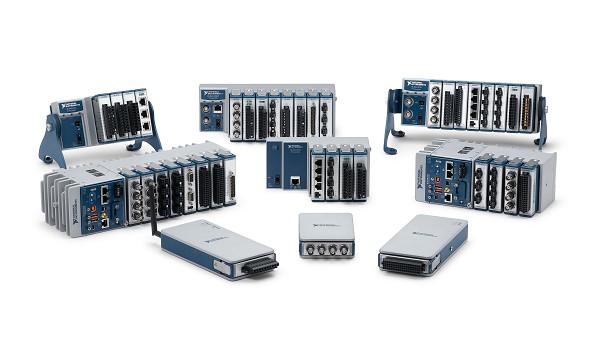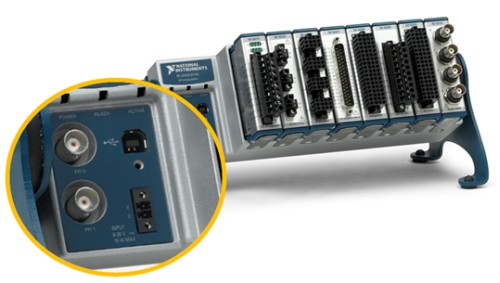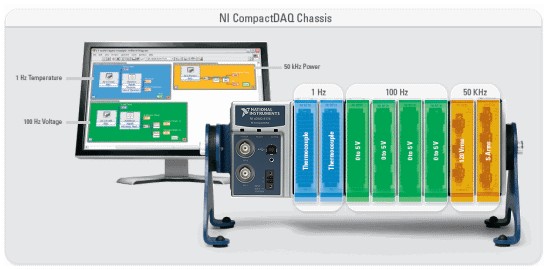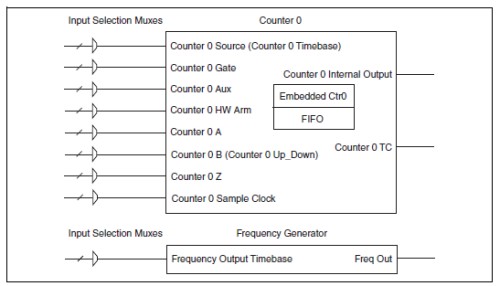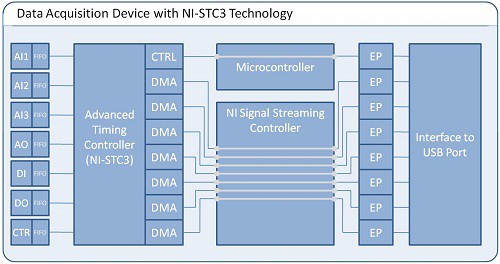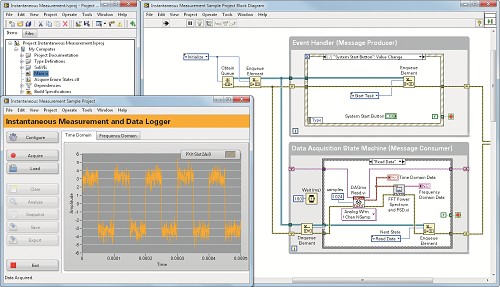CompactDAQ 技術:多組時序引擎、訊號串流及其他諸多技術
綜覽
內容
C 系列 I/O 模組
超過 60 款 C 系列 I/O 模組可供選擇,不同的量測作業,包含熱電偶、電壓、電阻溫度偵測器、電流、電阻、應變、數位訊號 (TTL 與其他)、加速規與麥克風。 各個模組的通道數從 1 到 32 個不等,能因應各式各樣的系統需求。 C 系列 I/O 模組將訊號處理、連線及資料擷取等結合到小型模組中,適用於各種特定的量測類型,能夠降低系統複雜度並提升量測準確度。 將這些模組插入於任何 C 系列機箱或控制器中,即可建立各種系統。 只要選擇所需模組,並將之安裝到多款 CompactDAQ 系統之一,即可讓單一系統具備不同的通道數與量測類型。 CompactDAQ 可用於建立適當的系統,因應量測應用的需求。
圖 1. 可供選擇的 C 系列 I/O 模組超過 60 款
內建處理器與儲存功能
CompactDAQ 控制器將處理器、資料儲存功能與資料擷取和訊號處理功能結合起來,精巧且堅固耐用,進一步整合了 DAQ 系統。NI 與 Intel 合作,在 DAQ 市場上推出工業級處理器,例如四核心與雙核心 Atom 處理器。此外,CompactRIO 搭載 NI-DAQmx 控制器可以將處理器和資料儲存功能與 DAQ 和訊號處理功能結合到 DAQ 系統中,讓系統達到同樣的整合效果,同時增加了使用者可程式化 FPGA 這項優勢,能在硬體中直接執行自訂的時序、觸發與控制演算法,從而發揮最大的穩定性與精確度。
機械設計
在設定測試作業時,儀器放置與安裝是其中重要的一環。USB、乙太網路、802.11 WiFi 及其他幾項通訊協定使用的數位訊號較不易受到電磁干擾,因此可以將儀器放置在測試目標附近,盡可能降低週遭電子雜訊。CompactDAQ 封裝精巧但堅固耐用,可以量測許多通道,適合放置於受測裝置附近。CompactDAQ 系統包含下列機械設計特性。
多功能機箱堅固耐用,安裝方式靈活多樣
- 能安裝 1、4、8 或 14 個 C 系列 I/O 模組
- 能透過 USB、乙太網路或 802.11 WiFi 傳輸資料,也可選擇配備嵌入式電腦的獨立式選項
- A380 金屬結構,耐久性優異
- 能承受 30 g 衝擊與 0.3 grms 作業振動,符合用於規範多數機箱的 IEC-60068-2-27/64 標準
- 能承受 50 g 衝擊與 5 g 作業振動,符合用於規範 cDAQ-9185/9189 機箱的 IEC-60068-2-27/64 標準
- 多數機箱和控制器能耐受 -20 °C 到 55 °C 的作業溫度
- cDAQ-9185/9189 機箱能耐受 -40 °C 到 70 °C 的作業溫度
- 面板、機架、DIN 導軌及桌面安裝套件
- 2D 和 3D 繪圖 (請參閱 ni.com 上的產品平面圖資料庫)
圖 2. CompactDAQ 機箱與控制器提供 1、4、8 或 14 式槽選項。
消除連接線與訊號線應變,做到堅固連接
- 電源連結功能以螺絲固定在機箱上,另附能發揮安全作用的保護背殼
- USB 連接線以大頭螺絲固定在 USB 機箱上 (固定用的 USB 連接線附在 USB 機箱組合中)
- 乙太網路連接線以閂鎖機構固定 (標準乙太網路連接線另售)
- 所有模組均附應變消除護套或可另購護套配件,防止接線脫落
- 衝擊與振動測試均在連接電源線、通訊傳輸線及模組訊號線的情況下進行
內建觸發線路,可匯入/匯出數位時脈
- 8 槽式與 14 槽式 USB 機箱有兩個用於連接觸發線路的 BNC 接頭
- cDAQ-9185/9189 機箱有一個用於連接觸發器的 SMB 接頭
- 頻寬最高支援 1 MHz 時脈
- 能同步多個系統 (系統同步化功能未必適用於所有模組,請參閱機箱手冊)
圖 3.特寫照,主體是 cDAQ-9178 的電源輸入、BNC 觸發線路與鎖住的 USB 連接埠。
模組與通道的自動同步化
- 插入更多模組,就能為系統增加更多量測類型與通道。
- 模組具熱插拔特性,插入 CompactDAQ 機箱或控制器後就會被系統自動偵測
- 單一 CompactDAQ 系統能同時串流高速類比輸入、類比輸出、數位輸入以及數位輸出
- 使用標準乙太網路連接線,能透過網路同步多個支援 TSN 功能的 CompactDAQ 機箱
- 使用 NI 9469 模組和 RJ50 連接線能同步多個 CompactDAQ USB 機箱
多組時序引擎可實現多種擷取速率
A/D 轉換器是 DAQ 系統中不可或缺的元件,它需要靠時脈訊號指定擷取樣本的時間點。許多系統都具備多個共用同一個時脈的 A/D 轉換器,用於同步所有通道的量測作業。CompactDAQ 系統的優勢在於其時序引擎相當靈活,且效能超越標準同步化功能。
CompactDAQ 機箱有三個類比輸入時序引擎。因此,程式設計師最多可以將所有類比輸入分成三個不同的群組,也就是所謂的「作業」:
- 每項作業皆可按不同的速率執行,如圖 4 所示。結合速度通常較慢的溫度量測作業與速度較快的量測作業 (如聲音與振動量測) 時,最適合使用這項功能。
- 這三項作業能獨立運作,可從程式中的不同迴圈或執行緒進行處理,亦可同時開始。
- 同一項作業中的所有通道均可自動同步化。若有一項作業結合運用一個多工模組與一個同步取樣模組,則將同步多工模組中的第一個通道,且將依次掃瞄多工模組中剩下的通道。
- 同一項作業中的所有通道,不分同步處理或是多工處理,均將以使用者所要求的取樣率回傳資料。
- 可以在同一項作業中運用所有模組。如此會按同一個時脈同步所有通道。
CompactDAQ 最多可以同時執行七項作業。使用者可以從數個作業選項當中選擇:
- 最多三個時序引擎的類比輸入
- 採用指定時序引擎的數位輸入
- 採用指定時序引擎的數位輸出
- 採用指定時序引擎的類比輸出
- 計數器/計時器作業適用於處理正交、PWM、事件、期間或頻率量測 (CompactDAQ 機箱內建四組計數器/計時器,可透過數位模組進行存取)
數位與類比輸出作業若有指派好的專用資源,就可以獨立執行,不必再與其他作業共用時脈訊號。如此程式設計就能更轻松、更為直覺式。所指派的資源亦可讓機箱的其他子系統所共用。舉例來說,若讓數位輸出時脈共用類比輸入時脈,就能運用數位輸入的每個升/降緣產生電壓。
多組時序引擎加上資源的分配與共用功能,使 CompactDAQ 的靈活性大幅超過多數現成可用的 DAQ 系統。
圖 4. 不同類比輸入作業可在同一個機箱中按不同速率執行。
CompactRIO 搭載 NI-DAQmx 控制器能讓使用者在控制器的每個插槽使用獨立的時序引擎,讓時序引擎發揮更高的靈活性。如此每個控制器最多可以有 8 個時序引擎,使用者就能使用 NI-DAQmx 將 8 個時序引擎全數靈活運用於程式設計,設計出 8 個全數按獨立採樣率同步執行的硬體時序類比輸入作業。
以 NI-STC3 技術達到進階的計數器功能
CompactDAQ 機箱和控制器的某項核心技術,亦可於其他 NI DAQ 產品中找到。此項技術即為第三代系統時序控制器 (NI-STC3)。許多裝置的系統時序都使用現成可用的時脈與震盪器。NI 技術優先考量系統效能,以時序引擎和 30 年電腦架構儀控經驗為基礎。NI-STC3 技術是內建於 ASIC 的專利原始碼,也是 CompactDAQ 這類獨立系統有別於市面上所有其他裝置之處。
四組進階的 32 位元計數器/計時器
- 計數器可用於事件計數、正交編碼器量測、PWM、脈波列產生,或是週期或頻率量測。
- NI-STC3 計數器之所以屬於進階計數器,原因在於具備嵌入式計數器或內建輔助計數器。計數器無法由使用者直接存取,對於特定的頻率量測作業,必須透過驅動程式存取。這些程序一般必須串聯兩組計數器,但透過 NI-STC3 技術,此進階計數器僅需更少資源即可達到更高效能。
- 使用者可以分享資源,將計數器作業與其他計數器、數位或類比作業同步。
圖 5.圖表顯示計數器 0 與頻率產生器。
內建頻率產生器
- 10 MHz、20 MHz 與 100 kHz 基本時脈
- 16 個除數 (n=1..16)
- 透過已安裝的硬體時脈數位模組或內建的 BNC 觸發器線路輸出 (內建觸發器線路頻寬上限是 1 MHz)
進階計數器與數位功能
- 變更偵測事件
- 硬體觸發 (開始、參照和暫停)
- 可程式化功能介面 (Programmable function interface, PFI) 端子用於輸入/輸出時序訊號,適用於類比、數位或計數器功能
- 8 個計數器輸入功能
- 5 個計數器輸出功能
NI 訊號串流技術
USB、乙太網路與 802.11 WiFi 等通訊匯流排均採用標準化的資料架構,並定義了裝置與主機的通訊方式,但並非所有裝置的條件均相同。獲得專利的訊號串流技術可以讓 NI DAQ 裝置在符合這些匯流排標準的範圍內發揮最高的運作效率。許多消費型產品只需要定向資料的一兩種串流。音樂播放器與儲存裝置通常是單向傳輸大量資料,也就是從主機電腦傳出資料或反向為之。測試系統通常需要同時執行多個輸入與輸出。訊號串流技術支援與 CompactDAQ 系統進行高速雙向資料串流。
圖 6.訊號串流技術支援在使用最少處理器的前提下平行串流多項作業的資料。
CompactDAQ 的軟體選項
透過 CompactDAQ 系統,使用者可在多種程式設計環境 (包括 ANSI C/C++、Visual C# 以及 Visual Basic .NET) 中開發量測與測試應用程式。不過,由於 LabVIEW 開發環境能緊密整合軟硬體,因此能透過最少的程式設計工作讓 CompactDAQ 系統發揮最大效能。
LabVIEW 是一種程式設計環境,以直覺式的圖示與接線建構流程圖開發複雜的量測、測試與控制系統。LabVIEW 能與包括 CompactDAQ 平台在內的數千種硬體裝置完美整合,更提供數百個內建函式庫,適用於進階分析與資料視覺化。使用這款符合工業標準的工具,可透過數台裝置自動進行量測、即時分析資料,並且在短短幾分鐘內建立自訂報告。
圖 7.圖形化程式設計與資料流呈現功能能讓使用者隨心所欲地進行程式設計,從而提高生產力。

